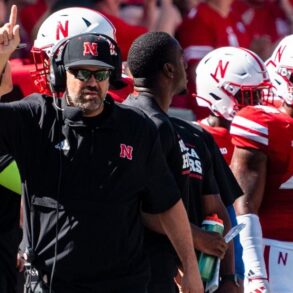
- Oklahoma and Texas’s move to the SEC in 2021 set off a chain reaction of college football realignment.
- The SEC is considering moving to a nine-game conference schedule to match other major conferences and strengthen their case for automatic playoff bids.
- The proposed changes could lead to further College Football Playoff expansion, potentially to 14 or even 16 teams.
In the summer of 2021, college football realignment changed forever. When it was leaked by the Houston Chronicle that the Oklahoma Sooners and the Texas Longhorns were moving from the Big 12 to the SEC, it got the ball rolling on a massive round of program movement.
Oregon, Washington, UCLA, and USC mvoved from the Pac-12 to the Big Ten. Cal and Stanford moved from the Pac-12 to the ACC. Arizona, Arizona State, Colorado and Utah went from the Pac-12 to the Big 12. The ACC later added SMU from the AAC. The Big 12 poached BYU from the FBS Independent ranks and took Cincinnati, Houston, and UCF from the AAC as well. And that’s just the moves that affected the Power Five (now the Power Four) conferences.
OU and Texas set in motion the demise of the Pac-12 as we knew it and so many other moves on the college athletics landscape. And now, there could be more changes to college football, all potentially a result of the Sooners and Longhorns moving to the SEC in 2024.
USA TODAY Sports staff writer Matt Hayes believes that Oklahoma and Texas’ decision is to blame for the current state of college football. College Football Playoff expansion is on the table once again. The real debate, though, is in the number of automatic bids allocated per conference. The SEC and the Big Ten are reportedly vying for four auto-bids a piece. But the SEC will have to move to a nine-game conference schedule to make that happen.
“Without two of the biggest programs in college football deciding in the summer of 2021 to light the fuse in search of financial stability, none of this happens,” Hayes said. “Not an expanding College Football Playoff postseason minimizing the bowl system. Not the unending thirst for more money — from universities and players. So it should come as no surprise that the final piece to this unique moment in college sports, the last step that four years ago was a pipe dream, has finally arrived. The SEC finally looks like it’s moving to nine conference games.”
The SEC’s choice to move to nine league games is one of the final moves in the current round of big-time changes to college football. Scheduling equity has been a big talking point in recent realignment as the SEC plays eight conference games while the Big Ten, Big 12, and ACC all play nine. A number of teams in the SEC play a school from the FCS. For the SEC to argue for automatic bids in the next round of expansion, they’ll have to be willing to play on the same scheduling field as the rest of the FBS. “In one significant offseason, and just weeks after the completion of the first 12-team CFP, college football is moving toward more radical change. Only this time, it looks like the last move,” Hayes said. “The fact that there’s “a lot” of interest from SEC coaches and athletic directors to move to nine games shows the financial straits even the heaviest of hitters in college sports face with the looming advent of what will be an effective “pay-for-play” system … Presidents and athletic directors see the final piece to the puzzle, and how it completes the final coat of paint on the completely rebuilt and reimagined college football.”
But Hayes’ point goes further, as this could lead to another change to the playoff, even though there was a change very recently from four teams to 12. Now, there could be a move to 14, or even 16 spots in the CFP. The reason is the newly-found cohesion between the sport’s two most powerful conferences.
“The SEC moving to nine games allows for alignment between the two super conferences of college football,” Hayes said. The Big Ten has been playing nine conference games since 2016, and the discrepancy between the two conferences has been a postseason qualification argument since,” Hayes said. “The potential change by the SEC opens the opportunity for the two conferences to build a non-conference scheduling agreement. Those games, and the nine conference games, is the driving factor behind selling more elite games to media rights partners ― and generating revenue from it.”
And, college football’s postseason could get even weirder after a somewhat lackluster debut for the 12-team edition of the playoff that included plenty of blowouts. The reason for expansion is simple: Money. In fact, if you’re looking for someone to blame besides the Red River Rivals, blame the almighty dollar.
“That expansion of games has now bled into the possibility of CFP play-in games during championship weekend, and expanding the postseason format to as many as 16 teams,” Hayes said. “More games, more money. Playing nine conference games and adding a non-conference scheduling agreement also allows the Big Ten and SEC to demand more access from the new College Football Playoff contract, which begins in 2026. Translation: automatic qualification, and as many as four spots per conference.”
Hayes also outlined what will happen for the other conferences.
“In that scenario, the Big 12 and ACC will receive two automatic qualifying spots each, and Notre Dame will still have access as an independent — if chosen by the selection committee,” Hayes said. “That leaves one at-large spot in a 14-team format, or three in a 16-team format. Expanding championship weekend to a College Football Playoff play-in weekend will increase the number of games affecting access from five (four power conference championship games, highest-ranked Group of Five champion) to 13. That’s eight more impactful games for media rights partners, and a corresponding increase in revenue. In one potential scenario, the SEC and Big Ten would each have four play-in games among the top eight teams in their respective conference standings, with the winners advancing to the CFP. The ACC and Big 12 would play two games from the top four teams in their respective conferences.”
College football’s NIL era has been hotly debated, to say the least. And expanding the playoff further does even more damage to the regular season, college football’s most important facet. And Hayes reiterates who he believes is ultimately to blame.
“All of this change from one monumental move four years ago,” Hayes said. “Blame Texas and Oklahoma. Or give thanks. Because the SEC finally will get to a nine-game conference schedule.”
The Sooners and the Longhorns may not be entirely to blame for the current state of college football, but it’s tough to deny that they didn’t at least have a hand (along with NIL and the desire for playoff expansion) in getting the sport where it’s at in 2025.
This post was originally published on this site be sure to check out more of their content.










